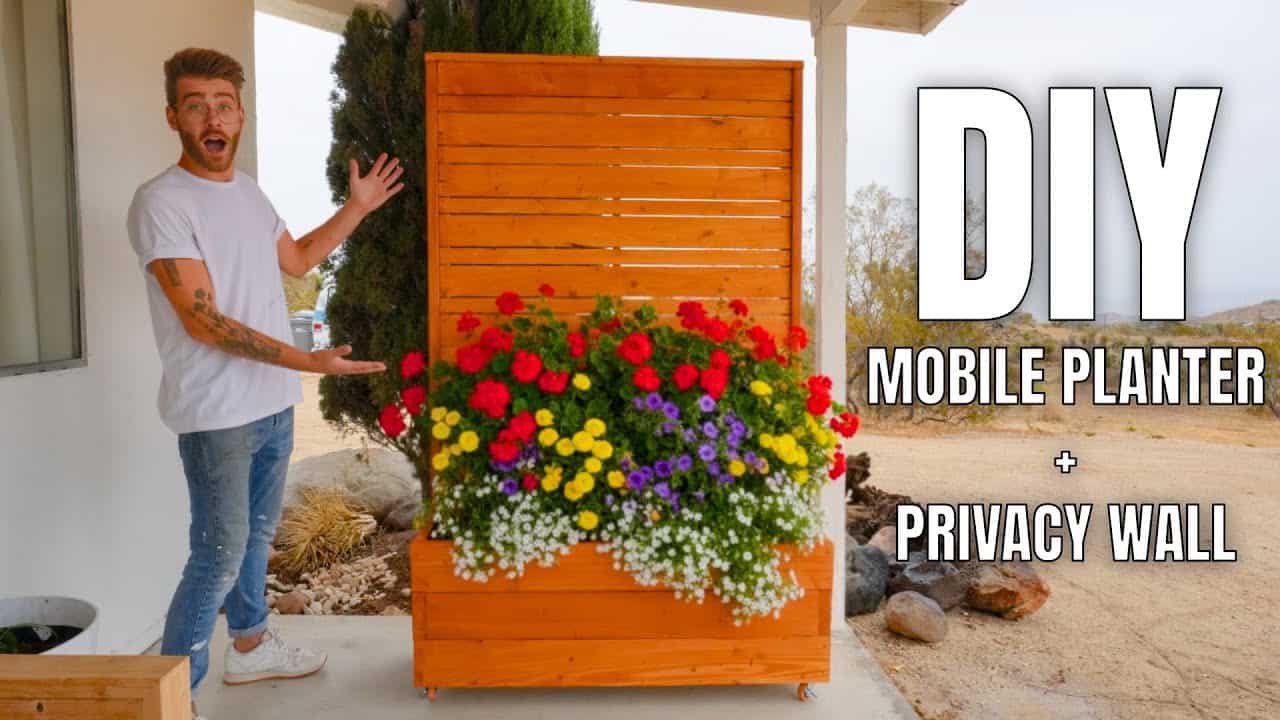This project was built and designed by Mike Montgomery of Modern Builds.
It’s a dual-purpose build: a deep, movable planter box with an attached privacy screen—ideal for porches, patios, or small yards where space and flexibility matter.
With basic joinery, off-the-shelf materials, and a design that balances weight and mobility, Mike shows how to build a structure that blocks views, shades sunlight, and still rolls away when needed.
Watch the full video and subscribe to Mike’s channel:
A Planter with a Purpose
This build combines two major outdoor needs into one structure—privacy and planting space. The deep base holds a generous amount of soil or fabric planters, while the vertical slatted screen provides cover from neighboring views.
What makes the design especially useful is its mobility. Heavy-duty locking casters allow the unit to be easily repositioned while keeping it stable when locked in place.
Smart Framing and Joinery
Instead of complex techniques, Mike sticks to simple, repeatable methods that anyone with basic tools can follow. The planter walls are built by gluing dimensional lumber edge to edge, with small dowels added for alignment during clamping.
After trimming the panels square, he assembles them with glue and exterior-grade screws. All exposed screws are countersunk and plugged with dowels for a clean finish—an easy upgrade that gives the piece a more polished look.
Building the Base
The planter box is reinforced underneath to support the weight of soil and plants. The base includes multiple planks for the bottom, attached to cross supports that distribute weight and provide a strong mounting point for casters.
A central block is installed where the casters will mount—this is critical for strength and prevents the screws from pulling out under load. Once installed, the casters allow the entire unit to roll freely, then lock in place for stability.
Designing the Privacy Panel
The back panel of the unit is where the privacy screen comes into play. Mike creates a framed slat wall using full-width and custom-ripped boards, alternating widths for a subtle modern look.
Each slat is screwed into a vertical backer board, which keeps everything aligned on a single plane. This backer also helps prevent sagging or bowing over time. A final cap board is added to the top to cover end grain and give the panel a finished, framed look.
Spacing for Looks and Function
Consistent spacing between slats is key to the appearance of the screen. Mike uses a thin spacer and a homemade drilling jig to keep gaps even and screw placements uniform.
This approach is easy to adjust. Want more light or ventilation? Just increase the gap slightly. Want maximum privacy or wind protection? Keep the spacing tight.
Assembly Tips and Clean Details
Pocket holes and pilot holes are used where needed, especially in structural joints. Wherever screws are visible, Mike hides them with flush-cut dowel plugs for a seamless face.
The use of trim-head screws for slats helps reduce visual distraction. Combined with uniform spacing and aligned fasteners, these details add up to a build that looks far more finished than its materials might suggest.
Finishing for Outdoor Durability
Mike sands the entire structure starting with a coarse grit to remove glue and raised grain, then moves to a finer grit for pre-finish smoothing. For outdoor protection, he applies an exterior-grade stain-and-sealer in a warm, natural tone.
Application can be done with a brush or applicator pad. The goal is to seal all surfaces, especially the end grains and bottom edges, to maximize water resistance and longevity.
Flexible Planting Options
Instead of rigid planter pots, Mike uses fabric grow bags that sit inside the box. These fabric planters are breathable, easy to lift, and perfect for rotating seasonal plants.
For this build, he added potatoes, but the size and depth of the planter make it suitable for herbs, flowers, or even small vegetables. When it’s time to water or rearrange, the bags can be lifted out easily without disturbing the rest of the setup.
Stability and Portability in One
With the privacy panel bolted into the back of the planter, the whole structure becomes one solid unit. Locking casters keep it anchored in place during wind or storms, and when needed, it can be rolled to adjust for sun, shade, or layout changes.
Mike notes that making a mirrored second planter would add symmetry to the porch and block views from multiple angles. The modular nature of the build makes this easy to replicate.
Small Touches That Add Value
Box joints on the corners add strength and a visual highlight to the front edges. Dowels in the glue-up stage help panels stay aligned, while alternating slat widths give the screen a high-end look with minimal effort.
Simple materials and accessible techniques make this project ideal for a weekend build, even for those without a large workshop.
Please support Mike by visiting his website: https://www.modernbuilds.com/.
